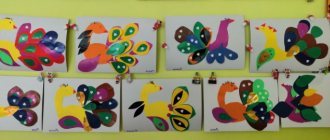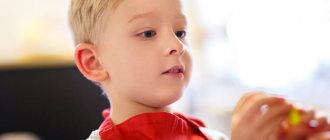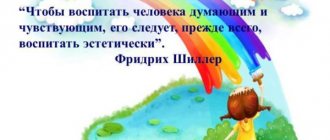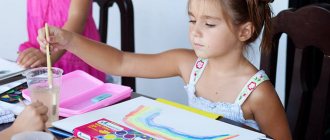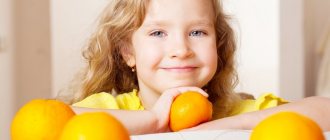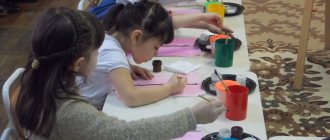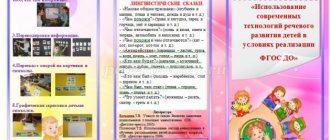What it is?
In pedagogy, the artistic and aesthetic development of a preschooler is understood as the formation of the ability to perceive the beauty of the surrounding world, as well as the development of the ability to show creative activity.
These qualities are developed in a child already in preschool age.
Artistic and aesthetic development performs the following tasks:
- Develops the emotional sphere of the child’s inner world.
- Helps accumulate aesthetic knowledge and standards.
- Forms the ability to enjoy aesthetic objects, as well as express one’s own attitude towards them.
- Develops abilities in the creative field.
These goals are achieved through various forms and types of aesthetic development.
Conversations are held with preschoolers on topics about the sublime and beautiful.
Communication with nature, which is an inexhaustible source of beauty, plays a big role.
In addition, it is important how the space in which children are is organized; it also has educational significance.
Preschoolers directly participate in a variety of creative activities - drawing, dancing, music, crafts, etc. In holidays and games, children embody artistic ideas that they became acquainted with during the learning process.
There are various forms of organizing artistic and aesthetic development:
- Games.
- Training sessions.
- Exhibitions.
- Excursions.
- Holidays.
IMPORTANT! It is necessary to select the form and type of activity in the artistic and aesthetic sphere in accordance with the age and interests of the students. The goals that the teacher strives for should be taken into account.
Artistic and aesthetic development of preschool children: concept, tasks and principles
Tatiana
Artistic and aesthetic development of preschool children: concept, tasks and principles
Aesthetic development occupies one of the leading places in the content of the educational process of a preschool educational institution. Currently, this area is highlighted as a priority along with the intellectual and physical development of children .
Aesthetic education
- this is the organization of the life and activities of children, contributing to the development of the child’s aesthetic feelings, the formation of ideas and knowledge about the beauty in life and art, aesthetic assessments and an aesthetic attitude towards everything that surrounds us.
For the aesthetic development artistic activities - musical, visual, artistic - speech, etc. - are of great importance . An important task of aesthetic education is the development of children’s aesthetic interests, needs, as well as aesthetic taste and abilities.
The great Russian teacher K. D. Ushinsky considered the aesthetic in human behavior as a form of manifestation of his morality. The boundaries between the moral and the aesthetic are arbitrary. By educating aesthetically, we improve a person’s moral qualities, his ideas about good and evil, duty and honor, conscience, and friendship. This is the main meaning of aesthetic education.
Back in the 70s of the twentieth century, generally positively assessing the system of aesthetic education in preschool development could not be built : the essence of aesthetic development , its difference from art , the role of living conditions and everyday life, the relationship between various educational means.
The entire range of questions put forward by the author is closely interconnected.
What is commonly understood today by artistic development , which, modeling various manifestations of life, is capable of clearly revealing aesthetic and spiritual value through art?
M. S. Kogan in the book “Human Theory of Values”
defines
artistic education based on an understanding of artistic culture . In his opinion, artistic culture is :
1) the universal space of artistic activity , that is, it covers all its various manifestations - literary, musical, stage and plastic, cinema, etc.;
2) artistic artificial artistic common to the whole world - a certain idea of the world and man, and then a creative method and artistic style in which these ideas are embodied;
3) artistic culture is a historically changing way of social organization of all artistic activity .
Based on this understanding of artistic culture , artistic education in the broad sense of the word is a way of including an individual in the artistic culture of society .
Artistic education involves:
1) fostering a love of art and artistic taste
2) development in the child of certain practical skills (drawing, singing, imagining, dancing)
3) imparting to the child certain knowledge in the field of theory and history of a particular type of art.
Artistic education
- purposeful activity aimed at wider inclusion of the individual in the artistic life of society . The solution to this problem has 2 levels :
1. To introduce the individual to contemporary art in all the diversity of its species and genre forms.
2. Introducing the individual to the artistic heritage , to the diversity of its historical layers, starting from ancient times and including the artistic culture of all peoples of the world.
This structure of artistic education is explained by the fact that great art survives the time of its creation and enters as a necessary component into the artistic culture of each new era; in the same way, the art of each people belongs to all humanity , organically entering the life of other peoples.
Artistic education involves the unification of three areas of educational activity:
1. Artistic education in the narrow sense of the word, i.e. the education of artistic taste as a psychological mechanism capable of ensuring an adequate perception of art and the formation of artistic consciousness - views , positions, ideals.
2. Art education , aimed at expanding a person’s knowledge in the field of history and theory of art.
3. Artistic education , designed to develop artistic creativity in one or more areas of art (regardless of whether a person becomes a professional or an amateur)
.
Aesthetic education
- a concept much broader than artistic . It is not limited to the sphere of art, much less to any one type of art, or to one of the possible forms of corresponding activity. The aesthetic culture of a person presupposes the development of his entire sensory sphere ( “aesthetic”
means
“sensual”
, emotionally responding to diverse natural phenomena and the most diverse aspects of reality. The main criterion here is the presence of a sense of beauty.
In the aesthetic education of children, the leading activity is artistic . Education, during which the artistic development of children , has great opportunities, but the process of assimilation of artistic experience is always individual. Acquaintance with art, introducing children to artistic activities is one of the ways of personality formation, the development of its inclinations and qualities, .
At the same time, by development we will understand a special type of change that is irreversible and necessarily involves qualitative transformations.
Aesthetic education is a complex and lengthy process. Aesthetic education is understood as the purposeful development in a person of an aesthetic attitude to reality, “the formation of a creatively active personality, capable of perceiving , feeling, appreciating the beautiful, tragic, comic, ugly in life and art, living and creating according to the laws of beauty.”
The main tasks of aesthetic education in domestic pedagogy are considered to be :
1. Education and development of a person’s aesthetic perception, aesthetic feelings, emotions, experiences, education of aesthetic taste, i.e. the ability to understand beauty in life and art.
2. Aesthetic taste is expressed in a value judgment. It reflects a certain aesthetic ideal, which testifies to a person’s ability to understand the essence of beauty.
3. Development of an aesthetic attitude to reality: the ability and desire to bring beauty into the surrounding life
According to N. A. Vetlugina, the formation of an aesthetic attitude to reality, which begins in early childhood, is of particular importance. A child’s aesthetic attitude to the environment includes his emotional response to beauty, his creative activity, the desire to appreciate harmonious combinations of colors, sounds, etc. A. A. Melik-Pashaev defines aesthetic attitude as a special perception and assessment of the surrounding life; as an artistic practice for children ; as an adequate perception of works of art.
The main means of artistic education is art itself, the experience of direct communication with it. The task of teachers is to organize this experience. Only then does the effect of artistic education when art has aesthetic value. That is why “ artistic and aesthetic education are tied into one knot.” [26, p.18] Therefore, the term “ artistic and aesthetic education ” is legitimate.
At preschool age, children receive their first artistic impressions and master various types of artistic activities . A characteristic feature of the interpretation of aesthetic education in kindergarten is that it is a purposeful process, organized into a single system and meeting the requirements of the comprehensive and harmonious development of the child .
N. A. Vetlugina in the theory of aesthetic education of preschoolers notes the importance of a systematic approach and defines its main features:
a) the integrity of aesthetic education as a substructure of comprehensive education and development ;
b) the determining role of educational and educational tasks development of the child ;
c) the totality of all means of education and forms of organizing the artistic activity of a child with the leading role of an adult;
d) mutual influence of parts of this subsystem.
Each of the listed characteristics has a certain place in the process of personality formation.
Describing a systematic approach to the aesthetic education of preschool , N. A. Vetlugina writes that all components of aesthetic education are closely interconnected, although some are leading and determining, others are more derivative. They influence the personality of each child as a whole, passing through the prism of his needs, interests, age and individual capabilities. It is very important, the author points out, that the teacher’s work in this direction is built on a scientific basis and carried out according to a specific program that takes into account the current level of development of art , in compliance with the principle of gradualism , consistent complication of requirements, a differentiated approach to the knowledge and skills of children of different ages.
In this regard, the tasks of the aesthetic education system listed above should include (according to I. F. Kharlamov)
and such as:
– formation of aesthetic needs in the field of art;
– students’ mastery of knowledge related to understanding art and the ability to express their judgments on issues of artistic reflection of reality;
– introducing children to artistic creativity , revealing their inclinations and abilities.
The system of artistic and aesthetic education and development is an organic part of universal human education; its organization, as noted by I. F. Kharlamov, is based on the following basic principles .
1. The principle of the organic connection of all artistic and aesthetic activities of children with life, the practice of renewing society (its essence is that the aesthetic phenomena of life and high art, organically connected with the life being transformed, form an aesthetic attitude to reality). Aesthetic education is not limited to the sphere of art, and especially to any one of its types. Aesthetic education should occur continuously and everywhere during the acquisition of knowledge, in the process of teaching the skills of any activity, in all contacts of the child with the environment.
2. The principle of unity of artistic and general mental development ( artistic and aesthetic activity ensures intensive development of children’s imagination , their emotional sphere, memory, speech, thinking).
3. The principle of consistency presupposes the constant improvement of aesthetic feelings, tastes, expansion of the emotional sphere, etc.
4. The principle of aestheticization of the entire child’s life requires the organization of relationships, activities, and communication of children according to the laws of beauty.
these principles with those that emphasize the uniqueness of artistic and aesthetic education and development of preschool children . In the “Creativity” program, for example, developed by a team of authors under the leadership of A. I. Smolyar, the artistic and aesthetic education and development of preschool children is built in accordance with the principles : taking into account the child’s play experience and his development in play activities; conformity with nature; creating an artistic and creative space ; complexity.
All the prerequisites for the artistic and aesthetic development developed and strengthened in it . The artistic potential of a child’s play experience is enormous; play experience is the main factor in the artistic and aesthetic development of children . A separate paragraph in this chapter will be devoted to this.
The principle of conformity with nature involves taking into account the nature of the child and the nature of art ( preschool childhood is valuable in itself , this is one of the most important stages in a child’s life).
The principle of creating an artistic and creative environment through joint aesthetic activity and active communication. The description of the environment as a factor in artistic and aesthetic development will be devoted to material in the second chapter of our work.
In artistic and aesthetic development, complexity is understood as the unity of different types of activity, in which the following conditions are met:
a) scientifically based content and methods;
b) implementation of the tasks of moral , mental, physical and aesthetic education and development ;
c) the emergence of new opportunities and ways of artistic exploration of reality, enriching children with various ways of conveying figurative content, awareness of search situations, and the formation of creative abilities.
The principle of complexity is manifested in the fact that the content of work with children is built in accordance with a single goal ( the development of an aesthetic attitude to the world, has the same psychological prerequisites, the general focus of creative tasks and games , is revealed through thematic unity, and is expressed in the methodological strategy of conducting classes. The process is artistic - aesthetic education and development of the child (children)
is built in such a way that art becomes the basis of the child’s life activity and life creativity.
The complexity of education presupposes the solution of all current problems of the systemic organization of artistic and aesthetic education and development , including the implementation of the principle of continuity as one of the fundamental principles in the formation and development of the education system of the younger generation. Improving continuity in the process of artistic and aesthetic education is facilitated by the close connection between the complex of pedagogical influences in preschool educational institutions and at school and the process of artistic and aesthetic development of children . Continuity involves the use of the most effective forms, means and methods of artistic and aesthetic education ; identifying new forms and means, based on the achieved level of artistic and aesthetic development of children . The significance of this problem is now especially increasing in connection with the creation of experimental programs in various types of art (fine art, music, as well as complex ones.
So, we can draw some conclusions.
Aesthetic development is a much broader concept than artistic development . It is not limited to the sphere of art, much less to any one type of art, or to one of the possible forms of corresponding activity.
The main means of artistic development is art itself, the experience of direct communication with it. The task of teachers is to organize this experience. Only then does the effect of artistic development when art has aesthetic value. Therefore, we can talk about the unity of artistic and aesthetic development .
The main tasks of artistic and aesthetic development from our point of view are:
• development of a person’s aesthetic perception;
• development of aesthetic taste;
• development of an aesthetic attitude to reality;
• fostering a love of art and artistic taste ;
• development of certain practical skills in the child (drawing, singing, imagining, dancing)
;
• imparting to the child certain knowledge in the field of theory and history of a particular type of art;
• wide inclusion of the individual in the artistic life of society ;
• familiarization of the individual with contemporary art in all the diversity of its species and genre forms;
• familiarization of the individual with the artistic heritage , with the diversity of its historical layers.
The principles of artistic and aesthetic development of preschool children are:
• the principle of an organic connection between all artistic and aesthetic activities of children with life and the practice of renewing society;
• the principle of unity of artistic and general mental development ;
• principle of consistency;
• the principle of aestheticization of the entire child's life;
• the principle of taking into account the child’s gaming experience and his development in gaming activities;
• principle of conformity with nature;
• the principle of creating an artistic and creative space;
• principle of complexity.
An analysis of the literature on developmental psychology allowed us to identify age-related characteristics that need to be based on in experimental work on the artistic and aesthetic development of children . They are as follows: children's animism, increased impressionability and susceptibility; non-standard and not lost primacy of perception; tentatively - the exploratory nature of sensory processes; sufficiently developed motor memory ; visual-figurative thinking (as a new development of preschool age )
; the beginning of the emergence of creative imagination; the ability to act consciously and voluntarily.
Activities to develop abilities in preschool age
There is a huge variety of creative activities that contribute to the development of artistic perception of preschoolers, who vary in age and type of creativity.
Classes for 3-4 years
REFERENCE! At this age, babies are just learning to express a positive reaction when they see familiar objects. They are not yet ready to perceive an artistic image, but choose certain pictures simply because they like them or resemble familiar objects.
One of the effective ways to develop artistic and aesthetic skills in children of primary preschool age is unconventional drawing. This provides an incentive to develop the ability to think outside the box and experiment. The arsenal of unconventional drawing is very diverse:
- Drawing with stencils - in this case, paint is applied to a pre-prepared stencil using a variety of tools: a sponge, a brush, a roller or even ordinary rags.
- Drawing with stamps, palms, leaves, cotton swabs, etc. - in this case, paint is applied to a stamp or something that replaces it and an impression is made on paper. Prints can be formed into patterns, and you can experiment with color.
- Drawing on wet paper differs from regular drawing in that paint is applied to a pre-moistened sheet and it spreads, creating unexpected patterns. At the same time, the child learns to follow what happens and guide the drawing process.
Modeling from plasticine not only forms artistic and aesthetic perception, but also promotes the development of fine motor skills, which is very important in preschool age. To deepen the effect of these activities, plasticine figures sculpted by children are used to dramatize fairy tales.
IMPORTANT! Musical classes can be either an independent form of creativity or accompany the creative process in other directions. For example, when a teacher turns on music while drawing or sings songs with children while dramatizing fairy tales.
Classes for 5-7 years old
REFERENCE: At the age of 5, a child is already able to receive aesthetic pleasure from contemplating a painting, but for him the color scheme is more important than the composition. At the age of 6-7 years, perception becomes much more subtle, children capture the inner mood of the image.
At this age, the possibilities for creative activities with children expand, as the children’s abilities also expand.
Older preschoolers have more complex skills and can complete more complex tasks.
For example, children 6-7 years old can engage in floristry, quilling, papermaking, etc.
Floristry is the creation of compositions from plant materials. It requires the child to be able to see the image, select the necessary shapes and shades of colors, and carefully work with fragile material.
For work, you can use leaves, flowers, twigs, moss and other plant materials.
Quilling is the making of pictures from rolled strips of paper. This is a rather painstaking task that requires patience and perseverance. Artistically, children learn to compose a composition and select colors.
Papermaking is an excellent tool for developing imaginative thinking. By making three-dimensional models from paper, preschoolers solve design problems, show imagination and aesthetic taste. Additionally, paper craft activities can be complemented by storytelling, drama, and other forms of creative development.
IMPORTANT! In older preschool age, children begin to get acquainted with the masterpieces of world artistic culture - paintings, architecture, literature (fairy tales, poems), etc. This happens in the form of conversations, viewing photographs, and reading.
Artistic development of children through fine arts
Children love to carefully examine even ordinary things; the ability to notice details can have a good impact on the ability to convey this on paper and other materials. The ability to draw develops attention, memory and perseverance. One very interesting experiment you can try is a mindfulness exercise. Ask your children to describe their favorite toy and draw a picture of it. Pay attention to details. Children will most likely draw an object symbolically, but they will definitely think about what kind of mustache a cat has, or what shape a dog’s ear is, or how many feathers are in a parrot’s tail. Then ask them to draw a picture of their pet or toy. They will be very attentive. You will be very surprised at the difference between these two drawings.
Just let children draw in peace every day without judging or criticizing their creations. There should not be a feeling that they have to “produce a product”, teach them to simply follow inspiration and not be upset by failures. In any case, drawing will stimulate children's imagination and enrich life with new colors.
Artistic development of children through watching films
Sometimes parents are unhappy that their children cannot be taken away from the TV. Take advantage of your child's habit of sitting in front of the TV screen and watch a good family movie with him. Form good taste in your child. Children's films often show the world through the eyes of a child; they carry important information for young viewers. There you can find answers to questions, choose a model of behavior and look at yourself from the outside.
Watching good films together has a beneficial effect on a child’s mental development: he develops self-confidence and a sense of community, involvement in society. It is important to share your opinion and impressions after watching. This has a positive impact on children's receptiveness to learning, their ability to think critically and express ideas competently. Today there are a great many documentaries that develop curiosity and increase the intellectual level.
Artistic development of children through reading books
Reading is a fundamental skill for functioning in modern society. At school, children are taught not only the ability to put letters into words, but also to love their native language and good literature. Many people are familiar with the fact that despite the abundance of children's literature, children do not like to read. Parents should pay attention to this and set a personal example from an early age so that the child’s development is harmonious.
Reading develops the mind . Teaching young children to read helps them develop their language skills. Reading also helps them learn to listen. Nowhere else will they discover so many new things as in books.
Reading develops imagination . While reading, a child can find himself anywhere in the world. He can feel like a king or an adventurer, a princess or a sorceress. Thinking and experiencing the lives of the heroes, the young man is looking for his place in life, learning to live and make important decisions.
Reading stimulates creativity . After reading an interesting, exciting book, you can encourage your child to come up with a better ending or something that would improve the plot. You can illustrate the story with your own drawings or make up another one with the same characters.
Artistic development of children through listening to music
Whether your child is an exceptional musician or not, research shows that learning music has beneficial effects on children's mental and spiritual development. Recent research has shown that music uses both sides of the brain, making it a valuable development tool. Music has a beneficial effect on a child's academic success, emotional, physical and spiritual development.
Music influences literacy development . Children who sing, play a musical instrument, or listen to music under the guidance of a teacher hear and perceive it in new ways. This activates brain activity and all mental processes.
Music awakens emotion . Every child needs an artistic “source of nutrition”, music can give him this. Sounds help you feel this world, admire the beautiful, they can awaken all the good in a person.
Music is a gift you can give to your child that will last a lifetime.

